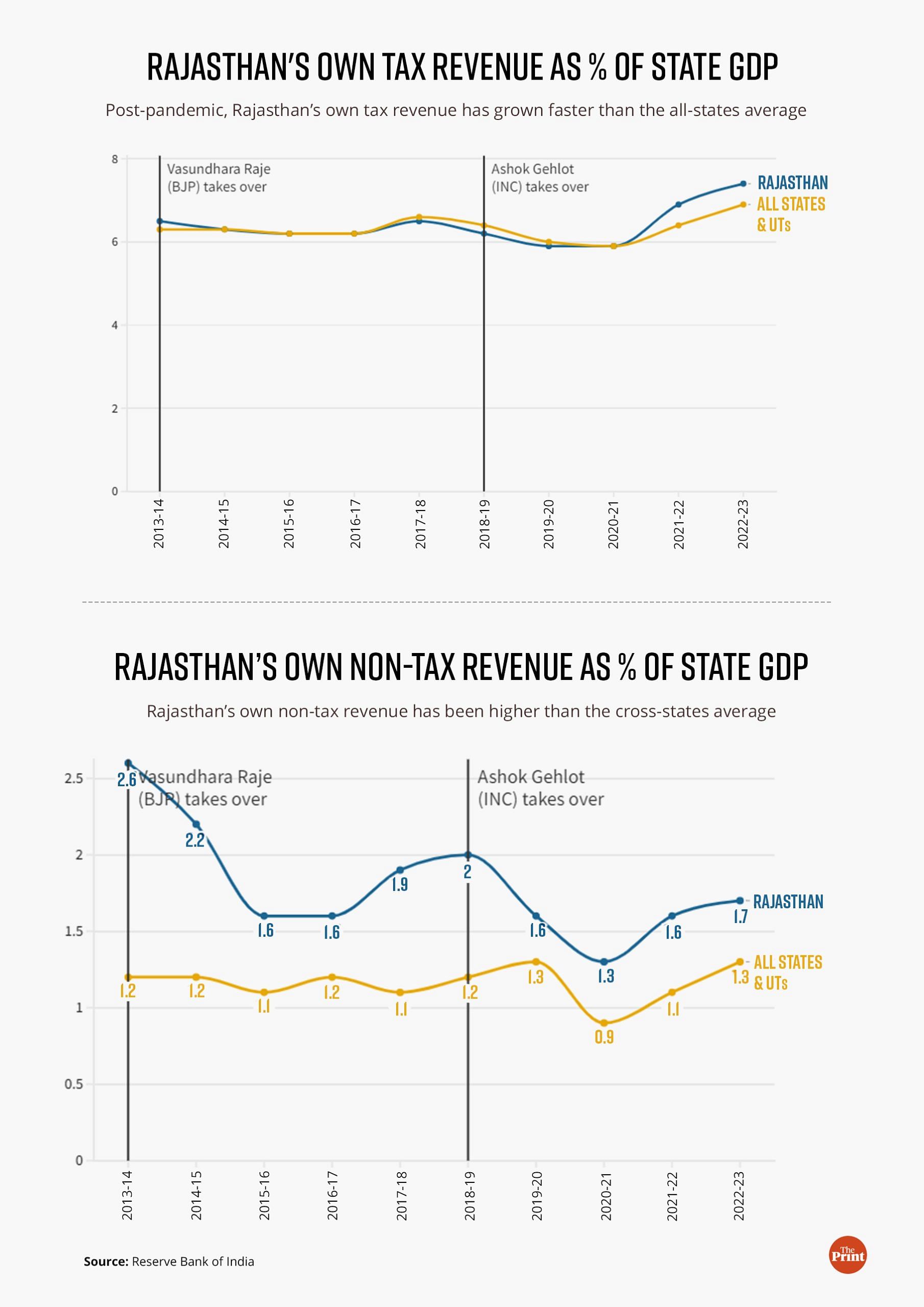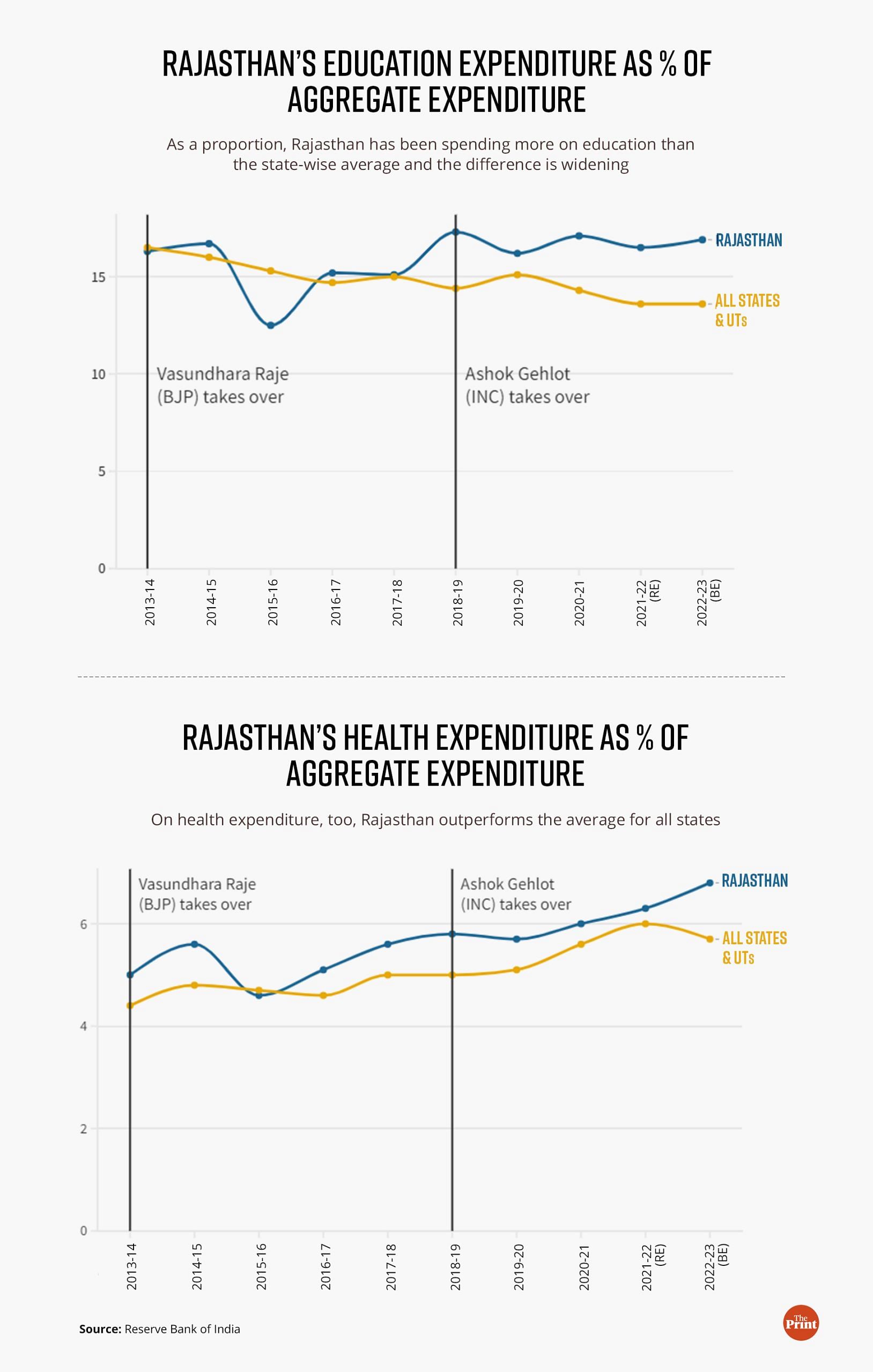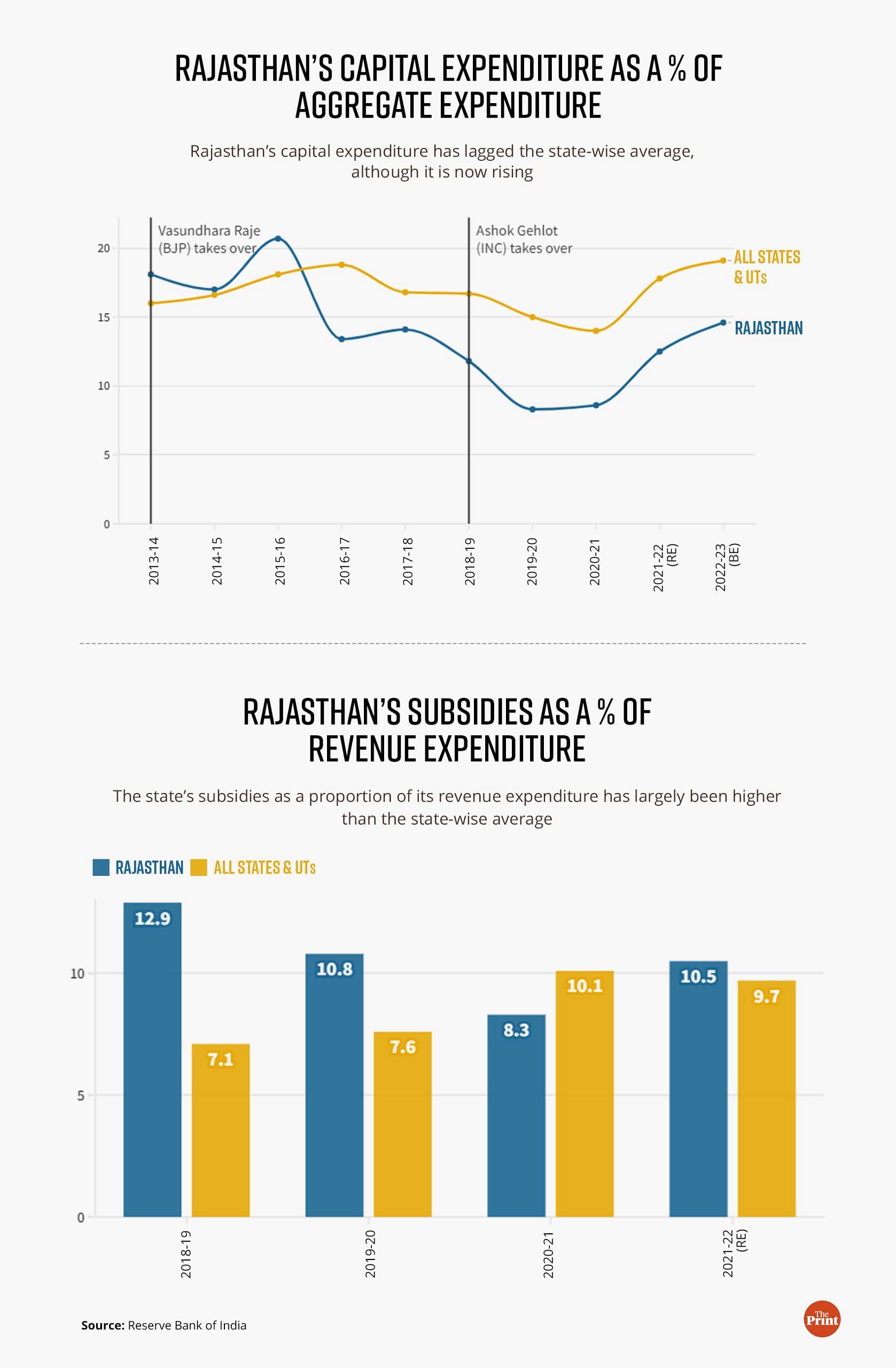New Delhi: Ever since the Ashok Gehlot-led Congress government in Rajasthan started announcing ‘freebies’ on LPG and electricity, it has drawn strong criticism from BJP leaders who have alleged that these schemes will hurt Rajasthan’s finances. forced to choose State.
Prime Minister Narendra Modi has also done in the past spoke firmly about what he saidrevdl culture’, or the practice of attracting votes by giving subsidies in some states.
However, an analysis of Rajasthan’s finances, comparing it to other states and its own history, shows that it is in a relatively strong position, and that its financial health has improved under Gehlot.
Not only is Rajasthan’s fiscal deficit – a measure of how much its expenditure exceeds its revenue – is falling, it has been falling more recently than the average for all states.
On the revenue side, Rajasthan’s receipts as a percentage of Gross State Domestic Product (GSDP) have been higher than the average for all states over the past decade. Recently, this gap has widened further.
Notably, the state has become more independent financially as well. That is, its own tax revenue and its non-tax revenue – money it earns without any help from the central government – have both been higher than the average for all states, and both have been rising recently.
On the expenditure side, Rajasthan is spending a higher proportion of its overall expenditure on social sectors such as health and education compared to the average for all states.
Where it fares poorly, however, is in capital expenditure, where its spending has been below average for some time now, but has also been rising in recent years.
On the subsidy front too, Rajasthan’s expenditure has been above average. Its subsidy expenditure as a percentage of GSDP was falling before the pandemic, at a time when it was rising on an aggregate basis for all states.
However, since the pandemic, Rajasthan’s subsidy outgo has gone up, while it has fallen for all states together.
Rajasthan government officials ThePrint spoke to said all this is part of a concerted strategy by the state government to boost the demand-side by giving people more money to spend. This is then expected to boost collections from the sale of goods and services and, thus, strengthen the state’s finances.
Economists say the decision to allocate more expenditure to ‘freebies’ – which is a part of revenue expenditure – rather than capital expenditure is down to the respective state government’s priorities, and one is not necessarily better than the other.
While capital spending can create jobs and create new wealth, subsidies in the form of cheap gas, free bicycles, or free sewing machines can serve as incentives for the natural gas, bicycle, and sewing industries alike, he says. .
“States spend on capital expenditure according to the size of their budgets,” explained Madan Sabnavis, chief economist at Bank of Baroda. “But it also goes without saying that this part of the revenue expenditure is unproductive.”
Other economists, however, believe that capital expenditure has a much greater impact in terms of promoting economic growth and job creation than it creates real wealth.
“Capital expenditure has a much larger multiplier effect on the economy than revenue expenditure,” said Manish Gupta, associate professor at the National Institute of Public Finance and Policy. “Capital spending in the form of building roads, bridges, hospitals, and schools also leads to job creation, demand creation for other related industries, and overall economic growth.”
Read also: Rs 500 gas for free electricity, welfare schemes doubling up as Gehlot govt’s election ads
maintaining fiscal balance
Fiscal deficit of Rajasthan during the pandemic year 2020-21- When expenditure exceeds revenue in a financial year As a percentage of its Gross State Domestic Product (GSDP), it rose to 5.9 percent from 3.8 percent in the previous year, an increase of 2.1 percent in a year. Sure, it went up in all states as well, but not as much.
On an average, for all states, the fiscal deficit increased from 2.6 per cent in 2019-20 to 4.1 per cent in 2020-21, an increase of 1.5 percentage points.
Since then, however, Rajasthan has done a good job of getting its fiscal deficit under control. As per the latest data available, the state has projected its fiscal deficit to be 4 per cent of GSDP in 2022-23, compared to an average of 3.4 per cent for all states.
This means Rajasthan has reduced its fiscal deficit by 1.9 percentage points in two years, compared to an average reduction of 0.6 percentage points across all states.
It is also worth noting that the fiscal deficit increased by 0.8 percentage points Raj of BJP from Vasundhara Raje From 2013-14 to 2018-19 That compared to a slightly lower increase of 0.5 percentage points under Gehlot.
strong and independent revenue
Under Vasundhara Raje, Rajasthan’s revenue receipts – the money it earns through means such as taxation – were mostly flat as a percentage of GSDP.
Under Gehlot, revenue receipts saw more change, first falling during the pandemic, and then a strong recovery for the subsequent two years.
What is more noteworthy, however, is that Rajasthan’s own tax and own non-tax revenue have been higher than other states in its total revenue receipts in the recent past.
i.e. while Rajasthan’s own tax revenue followed the same path In form of In other states till 2020-21, it has grown faster than the average since then. On the other hand, the state’s own non-tax revenue has been consistently above average over the past decade. This is due in large part to the fact that Rajasthan – being relatively oil rich – receives royalties for the oil produced in its territory. This is an advantage compared to most other states.

The growing share of its revenue, both tax and non-tax, means Rajasthan is becoming increasingly independent of the Centre, a major issue for many states that say they are, in fact, more dependent. went union government After the introduction of Goods and Services Tax (GST).
Read also: EWS is upon us as politicians now offer reservation in elections like freebies
What’s driving revenue growth?
ThePrint delved deeper into the state’s finances to find out how Rajasthan is increasing its revenue. A major portion (about 70 percent) of Rajasthan’s revenue receipts come from taxes. The rest comes from central transfers.
Tax receipts are divided into Rajasthan’s share in own taxes and central taxes.
Notably, as a proportion of Rajasthan’s total tax revenue, it declined from 66 per cent to 62 per cent during Vasundhara Raje’s tenure as chief minister, only to rise again to 67 per cent in 2022-23 under Gehlot.
In other words, Rajasthan became more dependent on tax devolution from the Center under Vasundhara Raje, and more independent under Gehlot.
A more in-depth analysis reveals that Rajasthan’s own tax revenue has benefited from the implementation of GST. That is, since GST, taxes on the sale of goods and services have made up a higher share of the state’s own tax revenue.
This is a better position than relying on other internal sources of tax revenue, such as taxes on electricity, or motor vehicles, as taxes such as GST are more comprehensive and apply to almost all goods and services.
According to Arvind Mayaram, economic advisor to the chief minister of Rajasthan and former Union finance secretary, the reason for this increased reliance on the state GST is that the state has implemented “light-touch” tax rules that “improve compliance without the need To keep on raiding”.
“It is part of a concerted effort by the state government,” he told ThePrint. “Which basically means that the systems that have been put in place result in better compliance without harassment and harassment.”
spending preferences
With revenues being better than average, it has to be argued that state expenditure is commensurate with this performance. Rajasthan’s data shows that its total expenditure on health, education and other social sectors has been above average.

That said, the data also shows that Rajasthan’s spending on capital formation has consistently lagged behind the average for all states. Budgeted at 14.6 per cent of total expenditure in 2022-23, Rajasthan’s capital expenditure is still well below the all-state average of 19.1 per cent, though it is still the highest in the last seven years.
However, over time the data shows that the Gehlot government has managed to reverse the massive downward trend in the state’s capital expenditure. Capital expenditure was 18.1 per cent of total expenditure in 2013-14, which declined to 11.8 per cent in 2018-19, when Gehlot took over. Since then, it has increased – except during the pandemic – to 14.6 per cent in 2022-23.

Another area where the Gehlot government falls below average is the amount the state spends on subsidies as a proportion of its revenue expenditure.
Revenue expenditure mainly consists of salaries, pensions and other expenditure which needs to be incurred on a recurring basis. In this, a large portion of the subsidy is usually seen as an increase in unproductive expenditure.
The available data on subsidy goes back only to 2018-19. This shows that Rajasthan was able to reduce its subsidy expenditure from around 13 per cent of revenue expenditure in 2018-19 to 8.3 per cent in 2020-21. During the same period, subsidy spending by states increased from 7.1 per cent to 10.1 per cent on an average.
However, after the pandemic, available data shows that Rajasthan’s subsidy expenditure rose to 10.5 per cent in 2021-22, while states on an average were able to reduce their share to 9.7 per cent.
“Many so-called freebies, such as gas, bicycles, sewing machines, or even subsidized fertilizers to farmers, provide incentives to specialized industries that produce these items,” Sabnavis said. “Some states may choose to boost their economies through this route instead of opting for capital expenditure.”
What Mayaram says about Rajasthan’s strategy is related to this. According to him, instead of focusing on the supply side like the central government, the state has tried to promote the demand side.
“When demand is falling, a supply-Side The push doesn’t really help the economy,” he explained. “In Rajasthan, we have paid more attention to demand side response. Welfare expenditure is seen as ‘freebies’ or unproductive expenditure.
Mayaram said, “If you are giving free gifts with a very clear idea in your mind that you are promoting demand, it results in higher tax collection.” “For example, look at (Rajasthan’s push for) gas now. They are going to give gas to BPL families for Rs 500, which means they will have more money to spend on other items.
(Edited by Tony Rae)
Read also: RSS affiliated SJM’s Ashwini Mahajan says, ‘Bribery is free form, bring law to stop it’